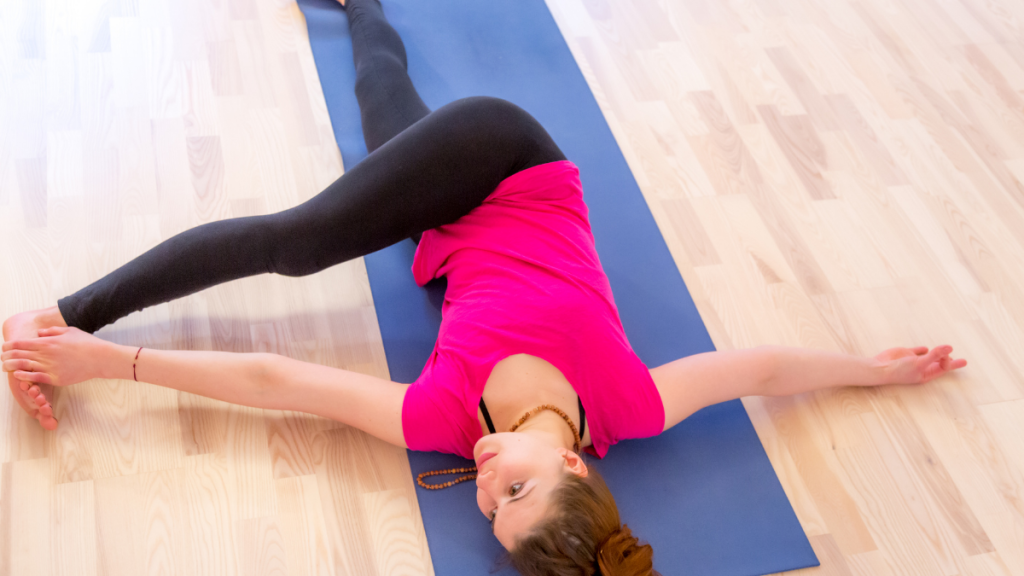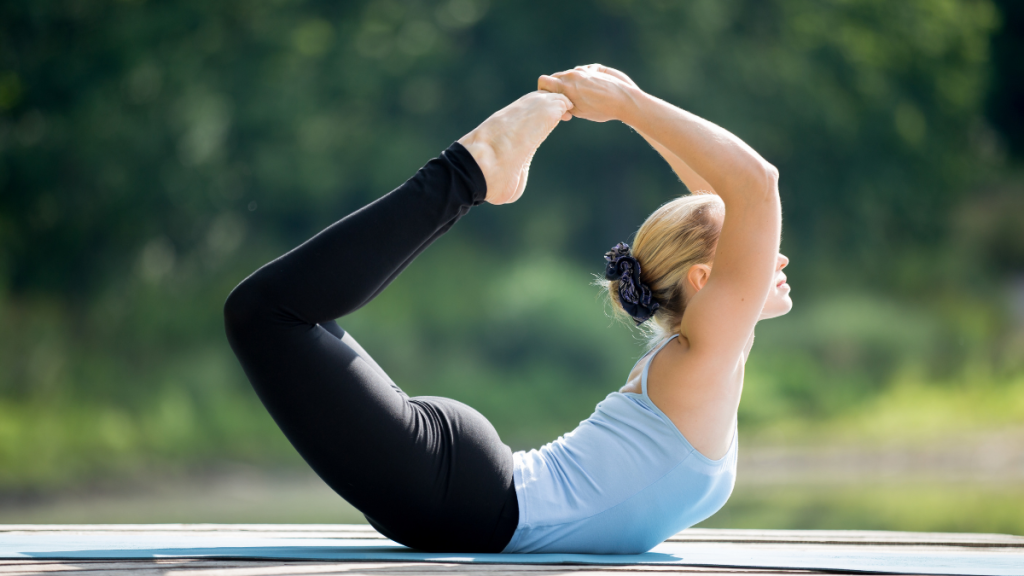Namaste Ji!!!🧘 Ever find yourself searching for a way to release tension after a long day? At Aatm Yoga Shala, we believe in the transformative power of supine yoga poses to soothe both the body and the mind. Whether you’re a seasoned yogi or a curious beginner, our serene space is the perfect sanctuary to explore the gentle stretches and calming breaths that define supine yoga poses practice.
So Are you ready to elevate your practice and delve into the ancient art of spinal yoga poses? Join us at Aatm Yoga Shala.
Our courses are specifically designed to enlighten and empower you on your path to wellness. With each asana, find the strength to confront life’s challenges and the serenity to embrace its joys. 🙏✨ Don’t let this opportunity slip away—secure your spot in our next course and transform your life with the timeless gift of benifits of yoga.Lets
What is Supine Yoga Poses?
Supine yoga poses are a cornerstone of relaxation and restorative practices, encouraging the body and mind to unwind and release tension. These poses are typically performed lying on the back, making them ideal for beginners or for those seeking a gentle stretch at the end of a long day.
They can help to realign and decompress the spine, open up tight chest and shoulder muscles, and promote blood circulation. By incorporating poses like the Supine Butterfly, Legs-Up-the-Wall, and Supine Spinal Twist into your yoga routine, you can experience a profound sense of calm and rejuvenation.
Regular practice of these restful postures may contribute to better sleep and improved overall well-being. Experiment with different supine poses and find the ones that work best for your body and mind.
With consistency and mindfulness, you can harness the benefits of supine yoga poses and incorporate them into your self-care routine. Remember to always listen to your body’s needs and consult a professional if necessary. Happy stretching!
Benefits of Supine Yoga Poses
- Promotes Relaxation: Supine poses such as Savasana allow the body to enter a state of deep rest, reducing stress and aiding in relaxation.
- Improves Flexibility: Poses like Supta Padangusthasana stretch the hamstrings and calves, enhancing overall flexibility.
- Enhances Digestive Health: Many supine asanas, including Supta Matsyendrasana, stimulate the abdominal organs, aiding in better digestion.
- Strengthens the Back: Practicing poses like Setu Bandhasana can strengthen the muscles of the back and improve posture.
- Encourages Mindfulness: Lying in supine poses gives practitioners an opportunity to slow down and become more mindful of their bodies and breath.
- Facilitates Healing: The gentle nature of many supine poses helps the body recover and can be therapeutic for various ailments.
- Increases Circulation: Inverted poses such as Viparita Karani help increase blood flow to the heart and can relieve swelling in the legs.
Here’s the table with Supine yoga poses, along with their benefits and ideal purposes:
| No. | Supine Yoga Pose | Benefits | Ideal for |
|---|---|---|---|
| 1 | Supta Baddha Konasana | Opens hips, stimulates abdominal organs | Relaxation |
| 2 | Supta Matsyendrasana | Increases spinal flexibility, aids digestion | Spine health |
| 3 | Viparita Karani | Relieves tired legs, calms nervous system | Recovery |
| 4 | Savasana | Promotes deep relaxation, reduces stress | Integration |
| 5 | Supta Padangusthasana | Stretches hamstrings, strengthens knees | Flexibility |
| 6 | Supta Virasana | Stretches the thighs and hips, aids digestion | Posture |
| 7 | Supta Parivartanasana | Stimulates internal organs, improves core strength | Core muscles |
| 8 | Ananda Balasana | Gently stretches the hips, thighs, and spine | Gentle stretch |
| 9 | Supta Tadasana | Lengthens the spine, relaxes the body | Spinal length |
| 10 | Setu Bandhasana | Strengthens back muscles, alleviates stress | Back strength |
| 11 | Halasana | Calms the brain, stimulates abdominal organs | Mental calm |
| 12 | Karnapidasana | Relieves stress and fatigue, therapeutic for back | Stress relief |
| 13 | Matsyasana | Stretches chest and neck, encourages deep breathing | Chest opening |
| 14 | Pavanamuktasana | Eases tension in the back, aids gastrointestinal comfort | Back relief |
| 15 | Uttanpadasana | Strengthens abdominal muscles, improves digestion | Core strength |
| 16 | Supta Garudasana | Releases lower back and hip tension | Hip flexibility |
| 17 | Chakravakasana | Improves mobility in the spine | Spinal health |
| 18 | Supta Trivikramasana | Stretches the leg muscles, balances nerves | Leg strength |
| 19 | Supta Balasana | Calms the nervous system, revitalizes the body | Nervous system |
| 20 | Jathara Parivartanasana | Enhances core and hip flexibility, detoxifies | Detoxification |
List Of 20 Explanation Supine Yoga Poses
Corpse Pose (Savasana)

The ultimate relaxation posture, Savasana or Corpse Pose invites practitioners to lie flat on their back, legs relaxed, and arms by the sides with palms facing upward. Close your eyes and breathe deeply, letting your body and mind enter a state of deep stillness.
Bridge Pose (Setu Bandhasana)

Bridge Pose is a back-bending posture that can be both energizing and restorative. With your knees bent and feet flat on the floor, inhale to lift your hips towards the sky, clasping your hands beneath your back for support.
Legs Up the Wall Pose (Viparita Karani)

Viparita Karani, or Legs Up the Wall, is an inversion pose that promotes circulation and relaxation. Simply lie on your back with your legs extended up against a wall, forming a 90-degree angle with your body.
Knee-to-Chest Pose (Apanasana)

Apanasana involves drawing one knee at a time toward your chest, holding onto your shin or knee. This gentle compression of the abdomen is excellent for relieving lower back pain and massaging the digestive organs.
Also read: 300 Hours Yoga Teacher Training And Benefits
Happy Baby Pose (Ananda Balasana)

This playful posture invites practitioners to lie on their back, open their knees, and grab the inner arches of their feet, resembling a happy baby. It’s another great pose for gentle stretching of the lower back and hips.
Reclining Bound Angle Pose (Supta Baddha Konasana)

With the soles of the feet together and knees opened out to the sides, recline onto your back for Supta Baddha Konasana. This pose offers a calm stretch to the inner thighs and groins.
Wind-Relieving Pose (Pavanamuktasana)

Pavanamuktasana, or Wind-Relieving Pose, is a simple, one-legged hug to the chest. This posture aids in digestion, helps to release gas, and stimulates the ascending colon.
Supine Spinal Twist (Supta Matsyendrasana)

The supine variation of the seated spinal twist, Supta Matsyendrasana stretches the spine and releases tension in the back muscles. Engage your breath to deepen the rotation with every exhale.
Supine Hand-to-Big-Toe Pose (Supta Padangusthasana)

Lying on your back, extend one leg up, holding onto your big toe with your peace fingers. This pose stretches the hamstrings and calf muscles, balancing the nervous system due to the effects of the breath.
Supine Pigeon Pose (Supta Kapotasana)

Supta Kapotasana calls for crossing one ankle over the opposite knee, drawing in the legs towards the chest. This gentle variation of pigeon pose stretches the outer hips and glutes.
Supine Bound Angle Pose (Supta Baddha Konasana)

With the soles of the feet together, elbows propped on each side, and hands supporting the belly, Supta Baddha Konasana allows for a supported inner thigh and groin stretch.
Supine Twist (Supta Jathara Parivartanasana)

Start with your knees bent and feet flat on the mat, then drop both knees to one side while keeping your shoulders grounded for Supta Jathara Parivartanasana. This is a great posture to relieve tension in the spine and back muscles.
Reclining Hero Pose (Supta Virasana)

This initial stage of Hero Pose involves reclining back between your feet or placing a bolster or cushion behind you for support. The posture offers a deep stretch to the quadriceps and the front of the body.
Supine Extended Triangle Pose (Supta Trikonasana)

Extend one leg diagonally and opposite arm to the back, then use your other hand to guide your leg or foot in the direction of the ground. Supta Trikonasana is an invigorating twist for the spine and a stretch for the hamstrings and calves.
Legs on the Chair Pose (Setu Bandha Sarvangasana)

Similar to Bridge Pose, but with your feet resting on a chair, Setu Bandha Sarvangasana offers a more restful experience while still promoting healthy blood flow and relaxation for the back.
Supine Big Toe Pose (Supta Padangusthasana)

Begin lying on your back, then bring one leg up, holding onto the big toe with your hand and extending the leg as much as possible. Supta Padangusthasana is excellent for the hamstrings, calf muscles, and the lower back.
Supine Eagle Twist (Supta Garudasana)

Cross one leg over the other thigh, then allow both legs to fall to one side for Supta Garudasana, or Supine Eagle Twist. This is a more advanced twist that deeply engages the hips and spine.
Reclining Hand-to-Big-Toe Pose (Supta Padangusthasana)

With a strap or towel, loop it around the arch of your extended foot for support. Recline back and extend the leg upwards with Reclining Hand-to-Big-Toe Pose for greater hamstrings and hip flexors stretch.
Reclining Goddess Pose (Supta Baddha Konasana)

A profoundly yielding posture, Supta Baddha Konasana invites practitioners to lie back with the soles of their feet together, knees opened to the sides, creating a butterfly shape with the legs for a deep inner thigh stretch and hip opener.
Prone vs. Supine Asanas:
The distinction between prone and supine asanas is the position of the practitioner. Prone asanas are performed lying on the stomach, which can strengthen the back muscles and improve flexibility. Supine asanas, performed on the back, often target relaxation and restoration.
Supine Yoga Poses for Beginners
Beginners can easily explore supine poses such as Savasana, Supta Baddha Konasana, and Viparita Karani, which do not require advanced flexibility or strength and can be modified with props such as cushions or bolsters for additional support.
Yoga Poses Lying on Back
Performing yoga poses on the back helps reduce tension in the body and calms the mind. It’s an ideal way to end a yoga practice, signaling the body to move into a state of recovery and healing.
By regularly integrating these supine yoga poses into your routine, you can enjoy both the physical and mental rejuvenating benefits, laying the foundation for a well-balanced yoga practice.
Encouraging Readers to Incorporate These Poses into Their Practice
We conclude by encouraging you to incorporate these 20 supine yoga poses into your regular routine to experience deeper relaxation and mindfulness. As you delve further into this practice, remember that each body is unique, and it’s important to listen to your body’s needs while performing these postures.
If you’re yearning for an even more immersive experience with yoga, why not consider a transformative Yoga Teacher Training Course at Aatm Yogshala in Rishikesh? This renowned yoga is rishikesh school offers a profound journey of self-exploration and learning amidst the peaceful setting of the Himalayas.
We hope this guide inspires you to explore the power of supine yoga and its ability to lead you to a more mindful and relaxed state. If you’re ready to take your yoga journey to the next level, book your course at Aatm Yogshala, where you’ll not only learn the postures but also the deep traditions and philosophies underlying this ancient practice.
Conclusion
As we draw our session to a close, the benefits of supine yoga poses resonate deeply within us. In the serene ambience of Aatm Yoga Shala, we have engaged in an intimate dance of breath and movement, releasing the day’s stress and aligning ourselves with a more mindful state of being. With each pose, we have invited peace and comfort into our bodies, promising ourselves a restful harmony that extends beyond the mat. Remember that this practice is a gift to yourself, a sacred time to honor your well-being. Carry the stillness and relaxation you’ve found here throughout your days, and know that our doors are always open for you to return, reconnect, and revitalize once more. Namaste.
Frequently Asked Questions
Q1: Can I practice supine yoga poses if I’m a beginner?
Absolutely. The supine poses provided are generally accessible to all levels, with variations to accommodate beginners and those with physical limitations. Remember to start slowly and work within the limits of your body, gradually progressing as you become more comfortable with the postures.
Q2: How long should I hold each supine yoga pose?
The duration of each pose can vary based on your comfort level and time constraints. It’s suggested to hold each pose for at least 5-10 slow, deep breaths to allow the body to fully relax and benefit from the stretch.
Q3: Do I need special equipment to practice these poses?
You don’t need specialized equipment, but a yoga mat, strap, and bolster can enhance your practice, especially when supporting the body in deeper stretches and longer holds.
Q4: Are there any contraindications for supine yoga poses?
While generally safe, supine yoga poses should be practiced with caution if you have specific conditions such as a recent or severe injury, herniated disc, or high blood pressure. It’s always best to consult a physician or a certified yoga instructor if you have any concerns.
Q5: How do supine yoga poses improve mindfulness?
The reclined nature of supine poses allows the body to relax deeply, which can help quiet the mind and facilitate mindfulness. Through the enhanced mind-body connection, practitioners can become more attuned to their internal state, emotions, and thoughts.
For an in-person transformational experience, connect with Aatm Yogshala and take the first step towards an enriched yogic lifestyle.



